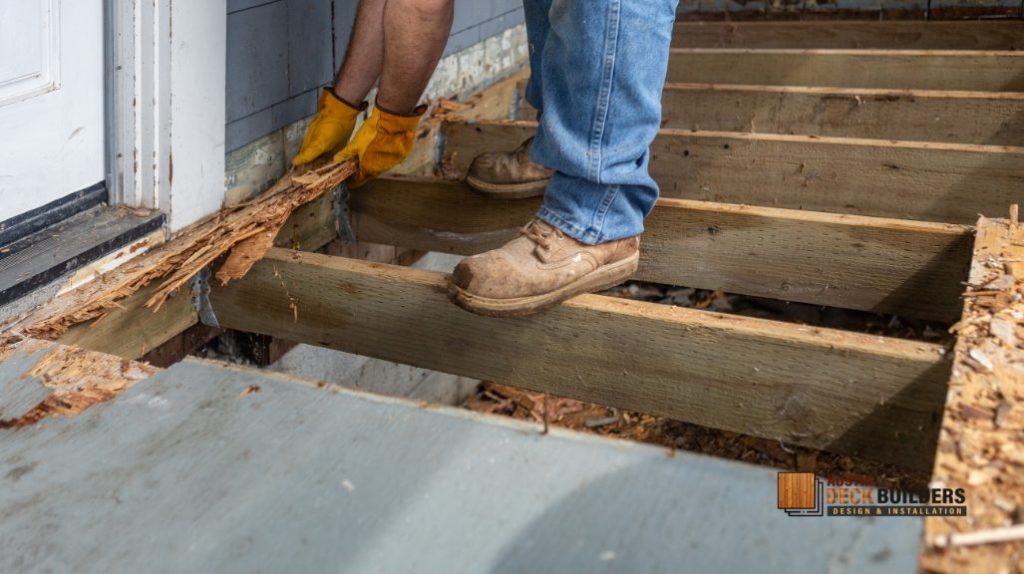TL;DR
Rotten deck posts threaten the safety and structure of your entire deck. This guide provides clear, step-by-step instructions on how to inspect, remove, replace, and seal rotten posts. Learn the signs of rot, when to tackle DIY projects, and when to call professionals in Austin’s humid climate.
Why Rotten Deck Posts Are Dangerous
Deck posts are the load-bearing pillars of your structure. When they rot, they lose the ability to support weight, resulting in sagging beams, shifting stairs, and eventual collapse. In Austin’s moist clay soils and humid climate, rot forms quickly—especially if the posts aren’t pressure-treated or are buried directly in soil without gravel drainage.
Step 1: Inspect for Rot Damage

Use a screwdriver or awl to press into the post at the base where it meets the ground or concrete pier. Signs of rot include:
- Soft, spongy wood
- Dark stains or fungal growth
- Splintering or crumbling at pressure points
- Leaning posts or sinking footing
If your deck sways or bounces, it may already be compromising its structural safety. You’ll want to schedule an inspection if unsure.
Step 2: Brace and Support the Deck
Before removing the damaged post, secure the area to avoid a collapse.
- Use hydraulic jacks and pressure-treated temporary supports.
- Place them beside the post and carefully lift just enough to remove the load pressure.
- Be cautious not to lift too far—deck shifting can create tension across joists.
If your deck is multilevel or large, consider hiring a professional to avoid potential structural issues.
Step 3: Remove the Rotten Post
Now that the area is supported:
- Unscrew brackets, beam connections, and remove joist hangers.
- Saw off the post above the footing.
- If it’s encased in concrete, chisel out the rotted section or replace the pier.
Fully rotted posts must be removed entirely—even a small portion of lingering decay can spread again.
Step 4: Choose and Install a New Post
The material you use can determine the longevity of your repair.
Material Options:
- Pressure-treated pine – Most common and affordable, but needs regular sealing.
- Cedar – Naturally rot-resistant but softer; often used for aesthetics.
- Composite posts – Low maintenance and resistant to decay, but more expensive.
Installation Steps:
- Anchor the post to a concrete pier using a galvanized bracket.
- Ensure there’s at least a 1″ air gap beneath to prevent ground contact.
- Fasten to the beam with carriage bolts, not just screws.
- Reinstall joist hangers, check for level alignment.
This step is critical for long-term durability. Learn more in How to Choose the Right Deck Materials.
Step 5: Seal and Protect the Repair

After securing your new post, you must protect it from future moisture:
- Apply a water-repellent sealant.
- Cap the top of the post to prevent rain penetration.
- Install gravel or a moisture barrier below the footing.
- Consider joist tape or flashing around contact points.
For full post and frame restoration, our repair and restoration services offer expert evaluation and lasting repairs.
Austin-Specific Considerations: Why Posts Rot Here
- Clay soil holds moisture against the base of posts.
- Frequent storms cause water pooling around footings.
- High humidity accelerates fungal growth.
- Improper flashing or sealing allows water to wick into untreated lumber.
Decks built 10+ years ago are especially vulnerable if they lack modern waterproofing methods. In neighborhoods like Travis Heights and Mueller, shifting soil only makes the problem worse.
Learn how to spot warning signs before they become costly repairs in our blog: Signs of Structural Damage in Your Deck.
Cost Breakdown: DIY vs Professional Repairs
| Task | DIY Estimate | Professional Estimate |
| Post Replacement (1 post) | $80–$200 | $300–$600 |
| Tools (Jack, Brackets) | $100–$250 | Included |
| Time Required | 4–6 hours | 1–2 hours |
| Warranty & Permits | No | Usually included |
If multiple posts are affected or rot has reached beams, a full deck renovation may be the smarter investment.
When to Repair or Replace Your Deck

A single rotten post can be replaced safely—but if more than one post is affected, or if beams are showing signs of decay, it’s time to assess the structure as a whole.
Refer to our guide: Deck Repair vs Replacement in Austin: How to Make the Right Choice. It helps you decide when a fix is enough and when a rebuild is worth it.

